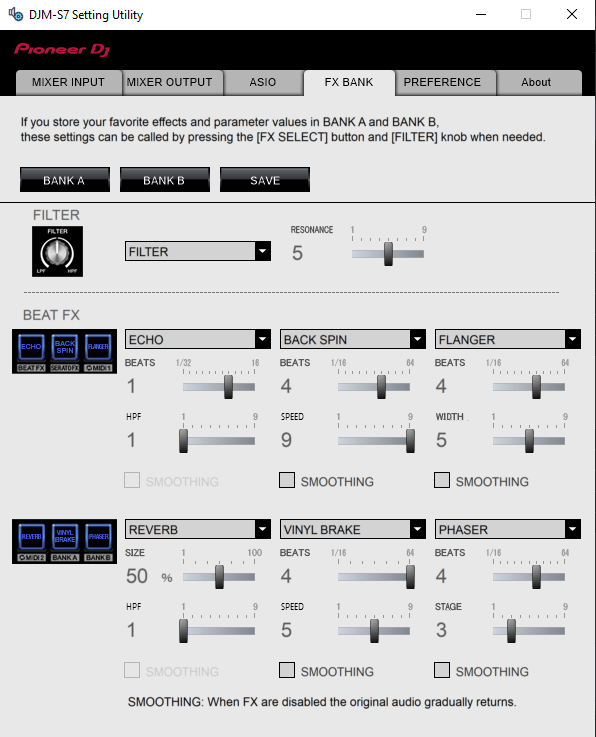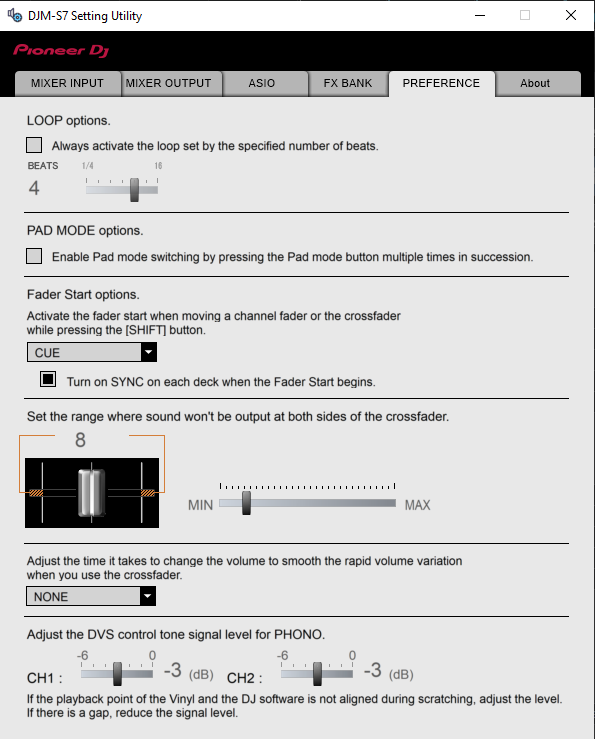PIONEER DJM-S7
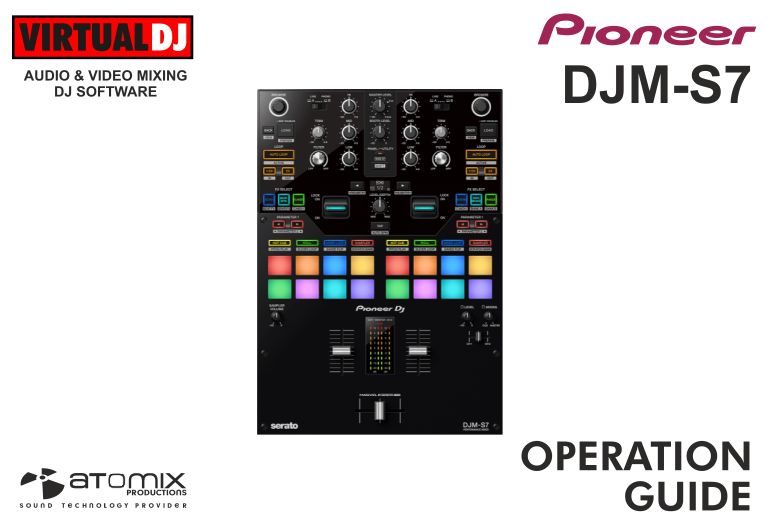
SETUP
Connections

- Connect your computer to USB port A or B at the rear panel of Pioneer DJM-S7
- Optionally, connect each of your deck’s RCA cables to ANALOG INPUTs CH1/CH2 respectively, depending on which software deck you wish to control.
Choose the LINE or PHONO Inputs depending on your device (CD player, turntable. Secure the ground wire to a Phono Ground terminal). - Set the SOURCE selector at the top panel for DECKs to the USB position A or B depending on the port you have used to connect with your computer.
- Connect the Pioneer DJM-S7 with AC power using the provided cable and power on the unit
Note: Usage of turntables or CD players (for DVS) is not necessary. The mixer may be used as a pure MIDI mixer. VirtualDJ is also offering the ability to control all the software decks with even with a single timecode unit. See Timecode (DVS).
Drivers
For Windows computers :
Install the latest ASIO driver from https://www.pioneerdj.com/en/product/mixer/djm-s7/black/support/
For Mac computers :
You don't have to install the driver software. Mac OS standard audio driver will be automatically installed when you DJM is connected to your Mac with a USB cable.
However, it is recommended to install the Mac Driver that allows you to change the settings of the DJM from https://www.pioneerdj.com/en/product/mixer/djm-s7/black/support/
There is no firmware update available at the time this manual is written, but is it advised to check at Pioneer DJM-S7 page https://www.pioneerdj.com/en/product/mixer/djm-s7/black/support/
VirtualDJ 8 Setup
Once VirtualDJ is launched, a Login Window will appear. Login with your virtualdj.com account credentials.
A Pro Infinity or a Pro Subscription License is required to use the Pioneer DJM-S7. Without any of the above Licenses, the mixer will operate for 10 minutes each time you restart VirtualDJ.
http://www.virtualdj.com/buy/index.html
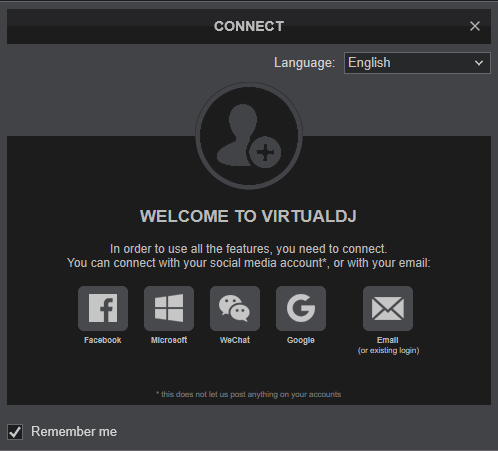
Click on the “DJM-S7” button and VirtualDJ will automatically create and apply the pre-defined audio configuration using the built-in audio interface of the Pioneer DJM-S7
Click to OK.
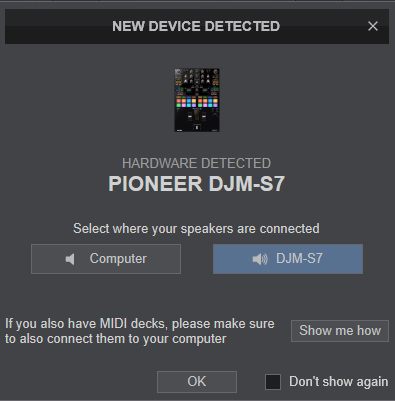
The unit is now ready to operate with VirtualDJ.
MIDI Operation
The unit should be visible in the CONTROLLERS tab of Config and the “factory default” available/selected from the Mappings drop-down list.

The factory default Mapping offers the functions described in this Manual, however those can be adjusted to your needs via VDJ Script actions.
Find more details at
http://www.virtualdj.com/wiki/VDJ8script.html
AUDIO Setup
The unit has a pre-defined Audio setup and a special button in the AUDIO tab of Config to provide that. Alternative setups can be applied in the same window. See Advanced Setup

For further software settings please refer to the User Guide of VirtualDJ.
http://www.virtualdj.com/manuals/virtualdj8/index.html
LAYOUT
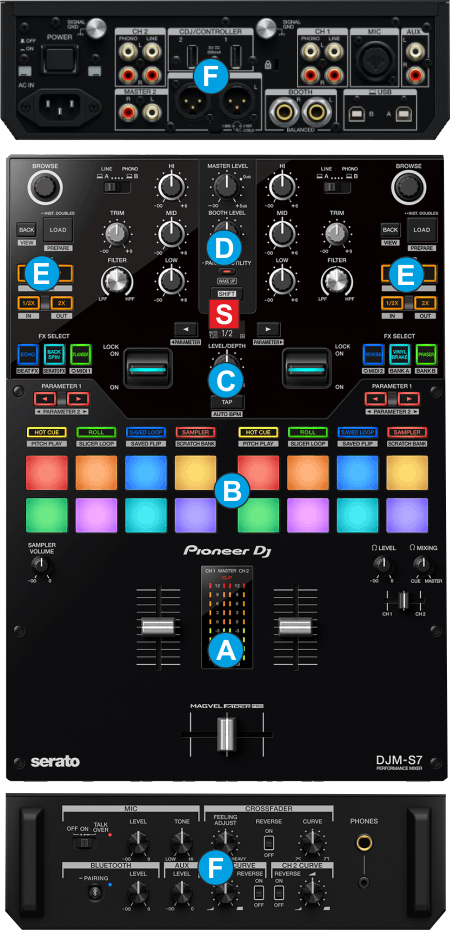
Even though the Pioneer DJM-S7 is capable of sending MIDI signals from all faders, buttons and knobs, the mixer part of the unit is not controlling the internal mixer of VirtualDJ. The audio mixing is operated from the hardware.
The Crossfader, Equalizer, Filter, Volume faders etc. will move the relative faders of the VirtualDJ GUI, but not vice versa (Fake mixer mode)
S. SHIFT. Press and hold this button to access secondary functions of other controls on the DJM-S7
The functionality of each button, knob and connection per section (as shown in the image above) will be explained in detail in the next chapters
A. Mixer Controls
B. Pads
C. Effects
D. Equalizer
E. Browser & Loop Controls
F. Front & Rear Panels
MIXER
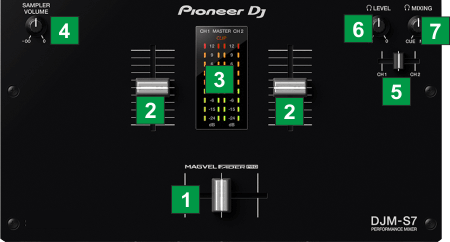
KEY
ACTION
SHIFT (SECONDARY) ACTION
Requires Fader Start/Stop/Sync feature enabled from Preferences
Requires Fader Start/Stop/Sync feature enabled from Preferences
Additional note
- The entire mixer section of the unit is Hardware operated. The VirtualDJ internal mixer is not used, even thought the knobs on the GUI follow the actual ones (fake mode)
PADS
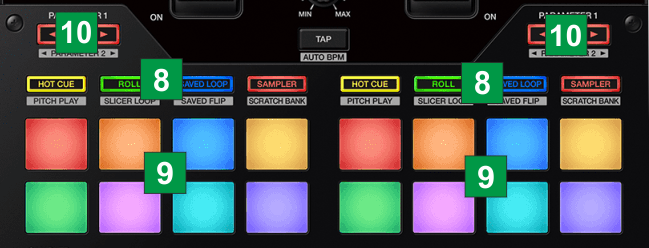
16 different modes can be selected for the Pads. When a Pad mode is selected ta relative VirtualDJ Pad page will be loaded on left/right deck. The pre-selected VirtualDJ Pad pages can be changed to your preferences from the Pad mode drop-down.
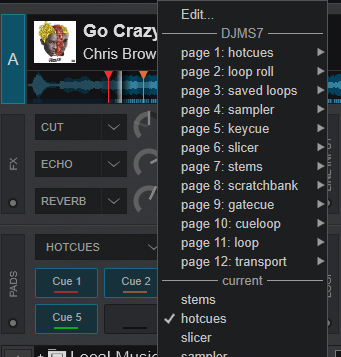
KEY
ACTION
SHIFT (SECONDARY) ACTION
HotCues(1st press - led white)
GateCue (2nd press - led red)
ROLL :
Loop Roll (1st press - led white)
CueLoop (2nd press - led red)
SAVED LOOP :
Saved Loops (1st press - led white)
Loop (2nd press - led red)
SAMPLER :
Sampler (1st press - led white)
Transport (2nd press - led red)
Selection behavior depends on the selected option from Preferences
Keycue (1st press - led green)
HotCues 9-16 (2nd press - led magenta)
ROLL :
Slicer (1st press - led green)
BeatJump (2nd press - led magenta)
SAVED LOOP :
Stems (1st press - led green)
Scratch (2nd press - led magenta)
SAMPLER :
Scratch Bank (1st press - led green)
Custom (2nd press - led magenta)
Selection behavior depends on the selected option from Preferences
TRANSPORT PAGE
In this mode each one of the 8 pads offers a different functionality as below:
PAD
ACTION
SHIFT (SECONDARY) ACTION
1
2
3
4
5
6
7
8
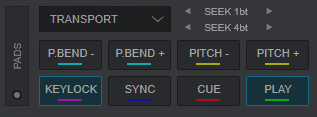
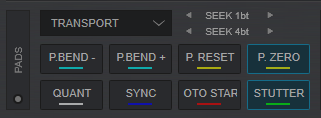
GATECUE PAGE
In this mode the 8 Pads will trigger Hotcues 1 to 8 , same as the Hotcues Page, but only while the pad is held down. When the Pad is released, the deck will be muted until the next HotCue point is pressed. Hold SHIFT and then a pad to trigger the HotCue point normally.
For more info about Pads , see /manuals/virtualdj8/interface/decks/decksadvanced/pads.html
EFFECTS
The EFFECTS section of the DJM-S7 offers the ability to select between 3 modes, Hardware Effects, VirtualDJ Effects and Loop Midi.

HARDWARE & SOFTWARE EFFECTS
Hold SHIFT down and then press the ECHO [11] button to select the Hardware Effects mode and apply Pioneer Hardware Effects to the Decks. Use the 6 FX SELECT buttons to select one (or more, if pressed simultaneously) Pioneer Hardware Effect and then use the LOCK ON paddles to apply the Effect(s) to the Left/Right Deck.
Different Pioneer Effects can be assigned to the 6 FX SELECT buttons. See Preferences
Hold SHIFT down and then press the BACKSPIN [12] button to select the Software Effects mode to apply VirtualDJ Effects to the Decks. Use the 6 FX SELECT buttons to select one (or more, if pressed simultaneously) VirtualDJ Effect and then use the LOCK ON paddles to apply the Effect(s) to the Left/Right Deck.
The Effects assigned to the 6 FX Slots of VirtualDJ can be selected from the GUI.

KEY
ACTION
SHIFT (SECONDARY) ACTION
LOOP MIDI MODE
In Loop MIDI modes the DJM-S7 repeatedly sends MIDI message to VirtualDJ Pro at a set beat value interval (based on the Deck's BPM, which allows you to trigger varying functions by simply pulling the FX LOCK ON paddles.
Two sets of pre configured Loop MIDI functions are available via the Loop MIDI 1 & Loop MIDI 2 modes, which can be accessed by holding SHIFT and pressing the FLANGER or REVERB FX select buttons
Press the FX Select button [11] to [16] to choose a Loop MIDI function as per the table below.
Toggle the FX paddle [17] to the ON or LOCK ON position to trigger the specified Loop MIDI function.
Use the FX Parameter left & right buttons [19] to adjust the timing of the MIDI interval.
KEY
LOOP MIDI 1 ACTION
SHIFT (SECONDARY) ACTION
KEY
LOOP MIDI 2 ACTION
SHIFT (SECONDARY) ACTION
EQUALIZER
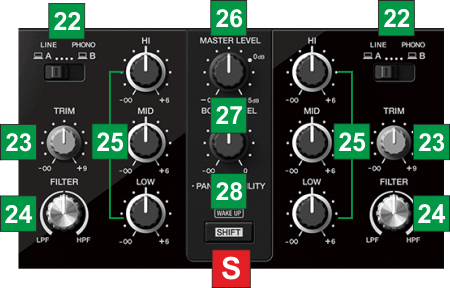
KEY
ACTION
SHIFT (SECONDARY) ACTION
Hold for more than 2 seconds to enter the Utilities menu of the unit.
Additional note
The entire Equalizer, Filter and Master section of the unit is Hardware operated. The VirtualDJ Equalizer (including Stems) and Filter are not used, even thought the knobs on the GUI follow the actual ones (fake mode)
BROWSER & LOOPS
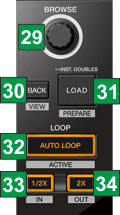
KEY
ACTION
SHIFT (SECONDARY) ACTION
Push to toggle focus between Folders and Songs List
Push to set focus to the Sideview List
Push the same button fast twice to clone the track from the opposite deck to the Left/Right Deck
FRONT & REAR PANELS

CONNECTION
Operation

CONTROL
Operation
ADVANCED SETUP
The Pioneer DJM-S7 offers 2 built-in audio interfaces with 2 stereo Outputs and 2 stereo Inputs each. The Mixer Inputs are determined by the Input Select switchers at the top panel of the unit.
The USB Output Channels can be set to different modes via the Pioneer DJM-S7 Setting Utility
How to open the DJM-S7 Utilities:
For Windows computer:
Click on the ASIO button you will find in the AUDIO tab of VirtualDJ Settings or ...
Click [START] menu [All Programs] [Pioneer] [DJM-S7] [Pioneer DJM-S9 Settings Utility]
For Mac OSX computer: (driver is required to be installed)
Click [MACINTOSH HD] icon [Applications] [Pioneer] [DJM-S7] [Pioneer DJM-S7 Settings Utility]
Timecode (DVS)
VirtualDJ is offering DVS (Digital Vinyl System) support for the Pioneer DJM-S7. Pro Infinity license is required. http://www.virtualdj.com/buy/index.html
Up to 2 Timecode Inputs are available to control any software decks via Timecode CDs or Vinyls.
Both Mixer Channels CH1 and CH2 can accept PHONO (for Timecode Vinyls). CD/LINE (for Timecode CDs)
Open the Pioneer DJM-S7 Setting Utility and set the USB 1/2 and 3/4 Channel Outputs to the appropriate mode (CD or PHONO Control tone)
In this example (as shown in the side picture), 2 Timecode TTs (vinyl) have been connected to CH1 and CH2
Close the Settings Utility
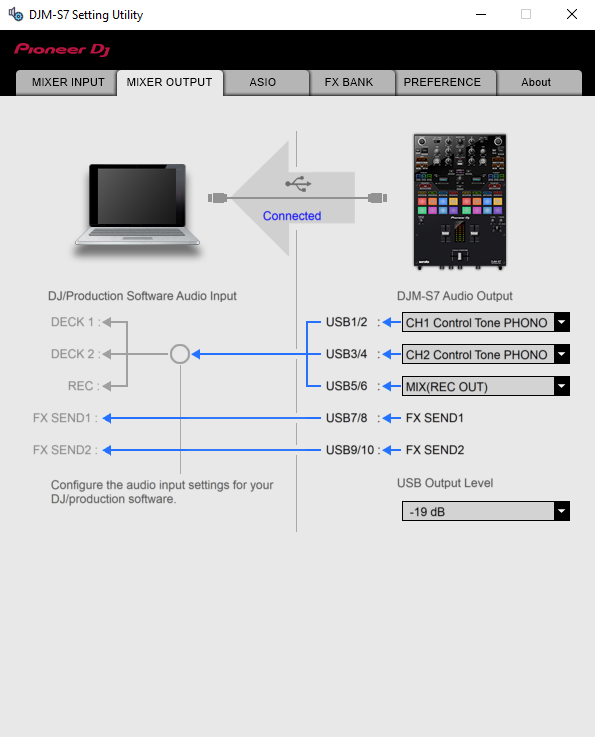
Press PLAY on your timecode CD and/or Vinyl device and VirtualDJ will automatically detect your Timecode type and make the appropriate adjustments for best performance.
Open the TIMECODE tab of the VirtualDJ Settings and choose the CALIBRATE button if for any reason the signal is not detected (possibly due to reversed phase connections).
Click on the ON buttons from the TIMECODE panels of the Default Skin to enable the Timecode control to any of the 4 software decks.
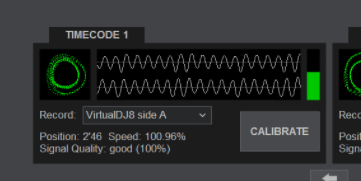
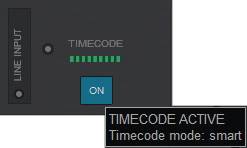
Recording
No adjustment is required in order to record (or/and broadcast) your mix with VirtualDJ. A record input is already pre-configured in the Audio Setup.. Just make sure the USB 5,6 Mixer Output from the DJM-S7 Utilities panel is set to REC (Out).
Open the MASTER center panel of the VirtualDJ GUI and click to the REC button (or BCAST for broadcasting) to record your mix.
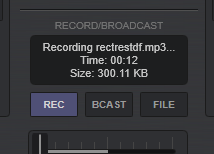
The dedicated record input will include any Mixer Input such as Microphone, CH or AUX Inputs.
Back to Back
The Pioneer DJM-S7 has two USB ports, allowing simultaneous connection of two computers. Each port is completely independent. It is possible to run VirtualDJ on one computer and any other 3rd-party DJ-software on the other, Mac or PC.
How to:
- Connect the 2nd computer to the unused USB port on the DJM-S7.
- Switch the Source Select switcher on the non-playing mixer channel to the USB source of the 2nd computer.
- Play a track on this deck and mix it when ready – you ll now have audio from both computers during the mix.
- Fade out the audio playing from the 1st computer to the audio playing from the 2nd one.
- When only audio from the 2nd computer is left in the mix, remove the first computer.
- Assign the Source select switcher for the remaining free mixer channel to the 2nd computer and keep mixing.
PREFERENCES
The Pioneer DJM-S7 Setup Utilities offer a few advanced options to choose from, such as the behavior of the LOOP buttons, the Fader Start/Stop/Sync feature for the Volume and Cross faders, adjustment for the Crossfader behavior and how the Pad mode buttons will be selected.
Make your adjustments via the PREFERENCES tab of the Pioneer DJM-S7 Utilities
You can also choose the Effects of the 2 available FX Banks via the FX BANK tab of the Pioneer DJM-S7 Utilities. The selection of the FX Bank on the DJM-S7 is done via the SHIFT + VINYL BRAKE and SHIFT + PHASER buttons.
